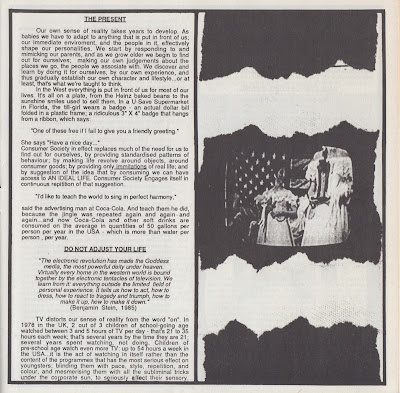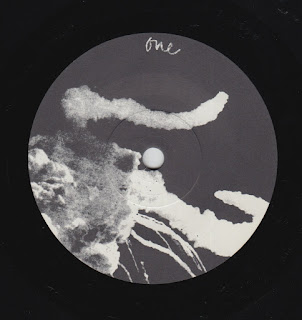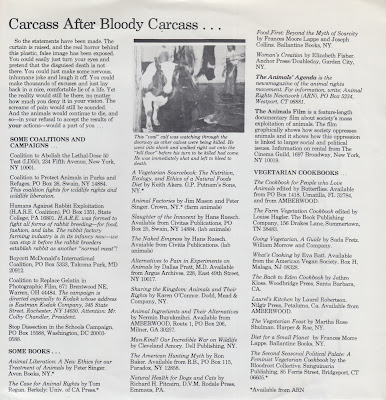Taken out of context, I suppose this split Ep can look slightly surreal in 2018. After all, it is a collaboration between one band that got to become a heavyweight of mainstream pop music in the 90's and another one that disintegrated not long after the record and is probably only remembered by punk nerds and those who were lucky enough to be part of the same scene at the time. The extent of this discrepancy is apparent only from a retrospective point of view and only matched by the degree of sonic similarities and political affinities that existed between Chumbawamba and A State of Mind in 1985. How different were to be their paths and yet how similar they appeared to be.
Arguably, this stark contrast must have been much more visible 15 or 20 years ago, back when Chumba were still famous, A State of Mind utterly unknown and the internet had not provided us with all the contextual information we now require and take for granted. The first time I heard Chumba was in 1998 playing the '98 World Cup video game (the tournament was taking place in France, you just could not escape it) because their song "Tubthumping" was used as the soundtrack and radio stations blasted the thing all day. At that time, I was much more interested in Rancid, NOFX and Green Day and did not pay much attention to them to be honest. Besides, France wan the bloody thing and, in the midst of the mass hysteria that ensued, I voluntarily forgot about the song (though I readily admitted it had a catchy chorus) and the band altogether, until a few years later, when I got my grubby hands on Aus-Rotten's Not One Single Fucking Hit Discography cd. Of course, I loved Aus-Rotten, their music and their message but this anthology of their early years was still confusing and a source of perplexity for me. At the end of the cd, there were some live recordings from the band, mostly covers actually. Aus-Rotten did versions of Flux and Conflict and, to be sure, that was perfectly normal. They also covered Upright Citizens, which I did not know at the time, but that did not really bother me, it was a very punky song. But then, they also played "30 years" from Chumbawamba. Yes, that band from the Playstation video game. I had vaguely heard that they used to be a punk band who "sold out for money and fame and shit" but I had not realized that they were an anarchopunk band (and they must have been, my younger self thought, since Aus-Rotten covered them) and probably a good one (again, since Aus-Rotten covered them, they must have been alright). But then the actual song was really not that good and - ironically - tuneless. So, what was I to think?
In these pre-internet days (for me anyway), I had no other options than to ask older punks (and judging from their reaction when I mentioned Chumba, either one of sorrow or contempt, I quickly understood that the subject was touchy indeed) or try to find some punk recordings of theirs. Which, after a few unlucky accidents - namely me buying Anarchy and English Rebel Songs two albums I absolutely hated at the time - I eventually did when I managed to find tape copies of early Chumba demos. The sound was abysmal (they were probably copies of old original tapes) but the songs were great, unique, interesting and, well, quite inspiring. So I finally understood what the fuss was all about and why (older) people were so disappointed when they signed up for EMI. For my generation, it was already a done deal and my first interaction with Chumba was through a Sony game so I am not going to pretend that I retroactively felt betrayed, but for the ones that got into them when they were still a crucial part of the anarchopunk fabric, I guess it was rather heartbreaking. I read somewhere that, basically, after the demise of Crass in 1984, two related but still significantly different anarchopunk paths lied before you, Chumba and Conflict, and it is probably no coincidence that Conflict have gotten so much criticism throughout the years too. It is just a personal point of view, of course, and I guess there was a third option with Antisect, Amebix and the nascent crust/hardcore scene, but the idea is interesting. There is little point in glossing upon the controversy itself here and now as the argument would, in the very different context of both the current music industry and the punk scene today, be irrelevant. But I can understand, though I don't necessarily condone, the radical anti-Chumba sentiments I still see expressed here and there.
But let's get to the record. At that point in time, ASOM and Chumba had very similar conceptions of punk music as an instrument for social change and as a vector of creation. The two bands were close (friends and comrades, I suppose, and they were even supposed to tour the States together at some point) and the Ep was as much as the result of this artistic and personal relation as it was meant to stand for the idea of communication and collaboration itself. I suppose there were other common points between both, structurally and creatively. They were collectives as much as proper "bands", embraced alternative lifestyles and were involved in political activism (on a theoretical as well as practical level). They were also influenced by early 80's anarchopunk while trying to bring more diversity and artistry to it at the same time, whether by literally importing elements from other musical genres into the punk recipe or by deconstructing the recipe itself (truth be told, neither went full on experimental or no-wave though, they still operated inside conventional music frameworks).
The two Chumba songs on this Ep were recorded in December, 1985, between the Revolution Ep and the Pictures of Starving Children Sell Records Lp (a cruelly mistaken statement if you consider the sales of crust records nowadays), which many consider to be the band's crowning glories. In fact, this split is often disregarded in the band's legacy, perhaps because it was released inbetween two genuine classics or perhaps because it was not as well distributed or perhaps because people are just not thorough. I dunno. This was Chumba at their (punky) greatest and the two numbers, "Invasion" and "Isolation", are proper hits. You can hear the very theatrical, histrionic nature of the band, the ir versatility as the songs effortlessly fly from emotion to emotion and genre to genre. "Invasion" starts as a cheesy pop song before exploding into a danceable postpunk beat and settling into a Crass-y tribal punk beat with brilliant vocal superpositions and a Flux-like bass line. Angry, intense, immensely catchy and uplifting. "Isolation" basically starts off where "Invasion" stops as the bass part is similar. However, after the first thirty seconds of anarcho delicacy the song morphs into a poppy reggae song before ending with deliciously tuneful canons over a simple drum beat and bass line. Just ace songwriting. I do not know how they did it but at that time anything they wrote turned into gold.
Of course, Chumba always had a tunefulness, a structural poppiness that made their songs so memorable (and I would argue that the joining of Mave and Daz from Passion Killers were probably instrumental in improving the band's tune detector) but there were other super tuneful anarcho bands around back then. What really set them apart was the ability to switch from 60's pop sensibility, to folk music, to angry and intense punk music, to catchy postpunk and so on, all the while telling a good, coherent story. Diverse but never disparate. That's the secret. Chumba are actually hard to describe properly but I tend to locate them in a certain brand of Northern anarchopunk sound (say The System, Kulturkampf or Blood Robots) but with a unique and refreshing innovativeness, a multimedia creative sense borrowed from Crass, a Zounds-like versatile theatricality and a love for the absurd not unlike The Fall or Adam and the Ants', a pop-punk touch like Lost Cherrees and, well, it is pointless to keep going I suppose. They really were their own. The history of the band is well documented now so keep digging if you feel like it.
On the other side (well not really actually, you've got one song from each band per side), ASOM probably epitomized what peacepunk was all about. The band - although I am guessing that the term "collective" was more appropriate - has an interesting story. They originally formed as a three-piece made up of Robbie, Allison and Kevin in Philadelphia in 1982. Robbie originally played the bass in Sadistic Exploits, a local band that had one Ep and whose drummer went on to play in YDI. In May, '82, the newly created ASOM played with Crucifix and White Cross at a Better Youth Organization gig in Phillie and then did a string of gigs with Crucifix who were touring the East coast. By 1983, the band had relocated to the Bay Area and the following months saw them recruit Rip (from Trial), Mark and Greg (from Atrocity) in the new ASOM.
Their first record was the 1984 Don't Vote... Subvert flexi which was a split with Liberté? (basically a collaboration between ASOM and Carolyn - aka Cyrnai - from Treason and subsequently Trial) revolving around the theme of voting, or rather not voting (I particularly enjoy the "Don't vote, subvert" chant shouted exactly in the same way as Crass' "Fight war, not wars"). It showed the band in a crispy Crass Records mood, with adequate fuzziness, and, were it not for the accents, it would sit nicely between Riot/Clone and Anthrax. It was released on the band's own Mind Matter Records, a label that would be active until 1987 and release works from Cyrnai, Danbert Nobacon (from Chumba) and Christ On Parade (who, I recently learnt, were a post-Treason band!). The next record, the quite good if raw What's the Difference? Animal/Humyn Exploitation Ep, recorded in June, '85, was a stronger effort. This time around, ASOM had Robbie and Kevin on vocals, Carolyn/Cyrnai on guitar, Greg on drums and Mkultra on bass. Recorded by Rip, the Ep was more diverse and illustrated the band's creative intent to incorporate different elements. What's the Difference? was all about animal exploitation, veganism and the ecological and political aspects of these issues. Though sloppy at times, it is a rather ambitious Ep with two dissonant punk songs in the grand anarcho tradition (somewhere between Flux, Anthrax and The Apostles), one melancholy acoustic song that is quite beautiful and a weird experimental dirge that I think is a bit too long to be included on a mere Ep... Oh well... In proper anarchopunk fashion, it is a foldout cover with plenty to read about animal rights and human freedom.
If ASOM had just recorded these two records, I do not think I would have considered including them in the series. They are decent, but not great. Their last offering however is brilliant and I cannot help but wonder what a full Lp of the band would have sounded like. The two songs ASOM contributed to the Chumba split, "Shit's pride" and "A bite of the apple...is not enough", were recorded in November, '85, by Peter Miller at his studio and that may be where the main improvement came from. The band's previous sessions had been recorded at New Method, a venue (and social center/rehearsal space I assume) ASOM were involved in, and I am guessing that working in an other studio with somebody else than Rip made a difference (Peter Miller also engineered for Crucifix, Christ on Parade or Septic Death so I suppose he knew his shit) especially in terms of intensity and overall balance.
To put it bluntly, ASOM sounded like San Francisco's Chumbawambas on this Ep. It feels a little strange to write this since they were actually sharing a record with a band they were also trying to emulate, but that's true. To be honest, I can hear other influences in ASOM's numbers, and a more accurate description would be - I think - a blend between Chumba and Alternative, with the first song sounding a lot like the latter while the second one borrows heavily from the former (the polyphonic quality of the vocal work and the melancholy folk music conclusion to the song are very highly reminiscent of Chumba). You know me, I am not hostile toward referential bands, on the contrary, I find them fascinating when they are well done and in this case, the execution is perfect. They could be Alternative or Chumba songs: moody, potent and proper catchy. After all some members of ASOM traveled to England in 1984 and met with Chumba (some of them would even tour with the Leeds-based band in '86) so the idea of one influencing the other is not silly or unreasonable. Odd perhaps since Chumba always tried to be unique and their own selves, but I cannot really blame a band for being influenced by Revolution and trying to emulate it, even in such a direct, obvious fashion. But then, wasn't it was peacepunk was also about? A re-creation of anarchopunk to fit the Californian context?
But anyway, on the split the ASOM lineup was Robbie on vocals and bass, Chris on guitar, Greg on drums and Juliet on vocals. The title of the record, We are the World?, of course referred to the famous song - written by the disgustingly cheesy USA for Africa - that illustrated how hypocritical the 80's charity campaigns sponsored by the show business industry and big corporations really were (a theme Chumba explored on their first album). The thick booklet details the military, economic and political neocolonial cooperation between the US and the British governments and how the citizens of these two countries are brainwashed into believing in the official propaganda from the cradle to the grave. It is an anti-patriotic, anti-governement record if you will. It was released on Agit-Matter Records, basically the fusion of Chumba's Agit Prop and ASOM's Mind Matter. The peacepunks then toured with the mighty Iconoclast in 1986 before calling it a day in 1987.















































